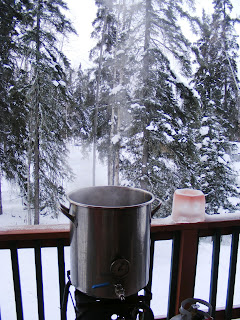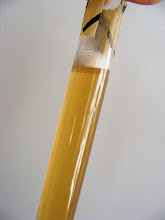Recently a friend of mine gave me a small fridge that she was no longer using. After about 20 years of bottling homebrew I thought it was high time to build a kegerator and start kegging my beer.
I like to incorporate parts of the natural world into my
projects when I can. Living in Fairbanks, Alaska,
I am surrounded by birch and spruce forests.
Looking at the birch trees in the yard and in my wood pile I noticed
that many were just about the right size for a draft tower.
I selected a piece
 of birch that was straight, had nice bark, was 3-3 ½ inches in diameter and about 12 inches long. I bored about a 2 ½ inch diameter hole through the log. I used a 1 inch spade drill bit to drill
out multiple holes from both ends and make a rough bore.
The job would have been much easier with a drill press and a 2-2/12
inch bore.
of birch that was straight, had nice bark, was 3-3 ½ inches in diameter and about 12 inches long. I bored about a 2 ½ inch diameter hole through the log. I used a 1 inch spade drill bit to drill
out multiple holes from both ends and make a rough bore.
The job would have been much easier with a drill press and a 2-2/12
inch bore.
Once I had the log bored out I decided to coat it with spar varnish to protect the fragile birch bark. I used a spray can applicator which worked well for the irregular surface of the tower. I applied numerous coats over several days until I achieved the thickness I was going for. The spar varnish did have a mild yellowing effect on the bright white birch. Perhaps gloss polyurethane would have had less yellowing but it would not provide as much protection as the spar varnish. If I were to do this again I would have applied the varnish before boring the log out. Clamping the unvarnished log marked the bark a little; this would have been avoided if I had varnished it first.
 I
bored out a 7/8 inch hole for the tap shank about an inch from the top and
dry fit the tap, shank, and elbow.
I needed to use a hand chisel to flatten the inside of the tower so
the beer nut could fit well against the inside of the tower. I also needed to carve out a little
extra room for the beer line elbow to fit in.
I
bored out a 7/8 inch hole for the tap shank about an inch from the top and
dry fit the tap, shank, and elbow.
I needed to use a hand chisel to flatten the inside of the tower so
the beer nut could fit well against the inside of the tower. I also needed to carve out a little
extra room for the beer line elbow to fit in.I wanted the tower to be stable on top of the refrigeration unit. Commercial towers come with a flange at the bottom to secure them to the base. I decided to make a base plate for the tower to sit on. I selected a nice section of 1”x6” pine and cut out and 8 inch section. I rounded the corners and used a 2 ½ inch
 hole saw to make a hole for the
draft line to pass through into the tower.
I made this hole centered about 1 ½ inches from the back of the
plate. After
I had the base plate shaped I applied a natural stain and finished it with
spar varnish.
hole saw to make a hole for the
draft line to pass through into the tower.
I made this hole centered about 1 ½ inches from the back of the
plate. After
I had the base plate shaped I applied a natural stain and finished it with
spar varnish.The tower fits over the hole in the base plate and is attached with four 1 ½ inch wood screws. The holes were predrilled to avoid splitting and for final assembly I applied a bead of silicone to provide a water/airtight seal.
With the tower almost complete it was time to start converting the fridge. I placed and marked my baseplate location on the top of the fridge.
The top of my fridge is a plastic plate. I removed this and using a 2 ½ inch hole saw I drilled a hole through the plastic to match the hole in the baseplate.
I re-attached the fridge top and used it as a guide to drill a hole through the top of the fridge. Use caution with this, MAKE SURE THE FRIDGE IS UNPLUGED. I knew there were no refrigeration lines in the top but I did not know where the wiring ran. I found the center of my hole and drilled a 1/8 inch pilot hole. Then, I carefully used the hole saw to cut through the outer sheet metal. I removed the piece of sheet metal and carefully cut away the insulation down to the plastic interior lining. In my fridge the wiring ran right under my hole and easily could have been cut into. Since the wiring was in the way I drilled out the plastic inner lining of the fridge using my original pilot hole as a guide.
 At
this point it was time to re-assemble everything. I placed the baseplate on the plastic
top with some silicone sealant and used ½ inch screws to secure the
baseplate to the plastic top.
At
this point it was time to re-assemble everything. I placed the baseplate on the plastic
top with some silicone sealant and used ½ inch screws to secure the
baseplate to the plastic top. Once the plastic top, baseplate, and tower were assembled I used foam backer strips and silicone to fill the gap between the plastic top and the fridge and re-attached the plastic top.
I passed the beerline from the interior of the fridge, up the tower and connected it to the faucet.
To cover the top of the tower I traced the shape of the tower onto a piece of birch bark which I then cut out. This made a lid to the tower which I finished with spar varnish and attached to the tower four ¼ inch wood screws.
This project was lots of fun and now I’ve got a beautiful kegerator of my own. It is great to be able to have my homebrew on draft after all those years of bottling. Next spring when the sap is running I’m going to have to make a birch beer to serve.











